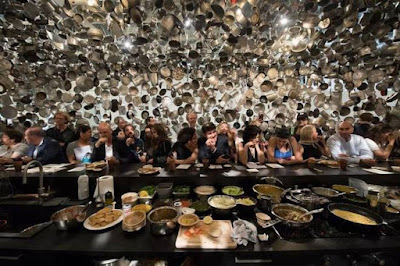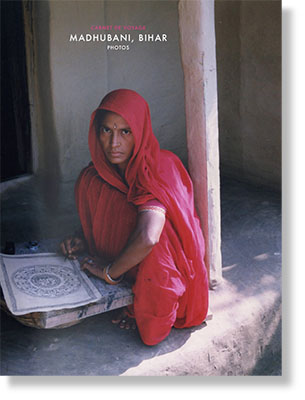

Source The Artling by Yunyi Lau
Early last year, a colourful cart appeared in the middle of Dharavi, a 3sqkm settlement located in the heart of Mumbai. On display were colourful pots and cups made by the inhabitants of what has been called one of the biggest 'slums' in Asia. These objects are a testament to the ability of these craftsmen to design and create despite the harsh environments they live in, and exactly what co-founders of Design Museum Dharavi - Amanda Pinatih and Jorge Mañes Rubio - sought to showcase. We speak to Ms Pinatih and Mr Rubio about the story behind Design Museum Dharavi and the possibility of having a museum that goes against the grain of the white cube space.
> read more
jeudi 29 juin 2017
This duo is breaking from the white cube model with design Museum Dharavi
dimanche 25 juin 2017
In the house that Gupta built

Source The Hindu by Georgina Maddox
Just over a week ago, a curious sight had got thousands of visitors at Art Basel Switzerland to pause, gaze, exclaim, and, finally, pull up a chair. Strung on reams of fishing wires, worn and discarded utensils from around the world were hung from the rafters at the fair’s Art Unlimited programme, creating a porous ‘house’ inside which Subodh Gupta, one of India’s most influential contemporary multimedia artists, conducted a culinary performance that elicited audience participation. Titled Cooking the World (2017) — and described as a cross between a restaurant and an installation — he and his team whipped up dal, khichadi, besan cheela (gram flour pancakes) and saffron yoghurt under the steel and aluminium canopy, and served them to whoever took a seat at their communal table.
> read more
Great European art tour part 2: From Kassel to Basel, a handful of Indian works spice up bland shows

Source Scroll In
From Athens, the first stop in our contemporary art tour of three of the world’s biggest festivals in Europe (you can read the first of our two-part series here) we moved to Venice, the host city of the oldest and best-known international visual arts exhibition in the world: the Venice Biennale. The core of the biennale is a curated show spanning two venues near the island’s eastern tip, the Giardini, or gardens, and the Arsenale, once a massive shipyard. Equally important are dozens of national pavilions, some displayed in permanent structures within the Giardini, others contained in the Arsenale or rented spaces in different locations in the city. India has usually ignored the Venice Biennale, causing much heartburn within the art community. To make the lack of an Indian pavilion more deeply felt, the curator of the core exhibition, Christine Macel, entirely ignored artists residing in India.
> read more
vendredi 23 juin 2017
Here's why local art collectors are in Germany this summer

Source Chicago Business by Lisa Bertagnoli
Interior designer Anne Kaplan, a board member at the Museum of Contemporary Art Chicago, went to the show on her own in June, starting in Athens, Greece, a new venue for this iteration of Documenta. "The exhibitions are powerful and poignant as we see the movements of goods, material and humans who are displaced by conditions beyond their control," Kaplan said in an email. Work she found intriguing includes photographs by Indian artist Gauri Gill and sculptures from Nigerian-born Otobong Nkanga. Works by both will appear in "Many Tongues," an upcoming survey of art from the Middle East and South Asia assembled by Omar Kholeif, MCA's senior curator. The show is scheduled to open Oct. 26, 2019.
> read more
mercredi 21 juin 2017
Experimenter Curators’ Hub
 Source Experimenter Kolkata
Source Experimenter Kolkata
Experimenter Curators’ Hub is a platform in developing and sustaining discourse on curatorial practice and exhibition-making through critical discussion and debate. Structured as a deeply intensive 3-day program, every year the hub invites some of the foremost curators of the world to present their practice with reference to recent exhibitions curated by them. The audience at Experimenter Curators' Hub plays an active role in this exchange and contributes significantly to the conversations. The final day ends with a moderated panel discussion with all the participating curators, reflecting on the key aspects that emerged over the three days.
> read more
mardi 13 juin 2017
Art-Fair Economics: Why Small Galleries Do Art Fairs Even When They Don’t Make Money

Source Artnet by Julia Halperin
Think art fairs are all about sold-out booths, comfortable shoes, and exclusive dinner invitations? Think again. For many small to mid-size galleries, fairs—like Art Basel in Basel, which opens to VIPs today—are an increasingly nail-biting gamble that involves paying hundreds of thousands of dollars up front with no guarantee of a payoff. As the middle market shrinks, many dealers are finding they can’t afford to do fairs—but they can’t afford not to, either. “It’s very hard to estimate what the revenue will be, so a gallery’s decision to do a fair is highly uncertain,” says Olav Velthuis, a professor at the University of Amsterdam who specializes in economic sociology. “People don’t realize that fairs are loss leaders for many small galleries.”
> read more
lundi 12 juin 2017
A look inside artist YG Srimati’s retrospective at The Met

Source Architectural Digest by Avantika Shankar
One of India’s most prolific modernists, YG Srimati (1926-2007) has only recently been brought back to public attention by a retrospective at the Metropolitan Museum of Art in New York. YG Srimati broke into the Indian arts scene at a time of immense political activity. The Independence movement was in full swing, British cultural dogma was being overturned, and there was a renewed interest in Indian cultural traditions. Indian artists were revisiting their ancient artistic roots, repurposing old stories from religious mythology to depict contemporary issues, and through the subversion of their Western classical training, were paving the way for an entirely new artistic tradition. The liberation of India brought with it the birth of the Indian modern art movement.
> read more
Not for Art’s Sake

Source The Indian Express by Vandana Kalra
The Venice Biennale is deemed to be the “Olympics of the Art World”. The participating artists are among the finest from across the globe, and the national pavilions strive to outdo themselves. But in recent years, India is nowhere to be seen. It has been to the Biennale only once, in 2011, helmed by the Ministry of Culture and the Lalit Kala Akademi. There has been no official showcase since, though our artists have been part of the Biennale’s central exhibition a number of times. A significant first was at the last edition of the Biennale in 2015 when The Gujral Foundation funded the showcase titled ‘My East is Your West’, with works of Mumbai-based artist Shilpa Gupta and Lahore-based Rashid Rana.
> read more
mardi 6 juin 2017
Journée portes ouvertes samedi 10 juin (sur inscription)

Source Galerie Hervé Perdriolle
De l'art contemporain indien à la Figuration Libre en passant par l'art brut, venez découvrir les passions et la collection d'Hervé Perdriolle dans sa galerie en appartement. Journée portes ouvertes le samedi 10 juin de 10h à 19h. L'adresse complète vous sera communiquée exclusivement sur inscription par mail : h.perdriolle(at)gmail.com
Archives revue de presse
-
▼
2017
(251)
-
▼
juin
(9)
- This duo is breaking from the white cube model wit...
- In the house that Gupta built
- Great European art tour part 2: From Kassel to Bas...
- Here's why local art collectors are in Germany thi...
- Experimenter Curators’ Hub
- Art-Fair Economics: Why Small Galleries Do Art Fai...
- A look inside artist YG Srimati’s retrospective at...
- Not for Art’s Sake
- Journée portes ouvertes samedi 10 juin (sur inscri...
-
▼
juin
(9)



















